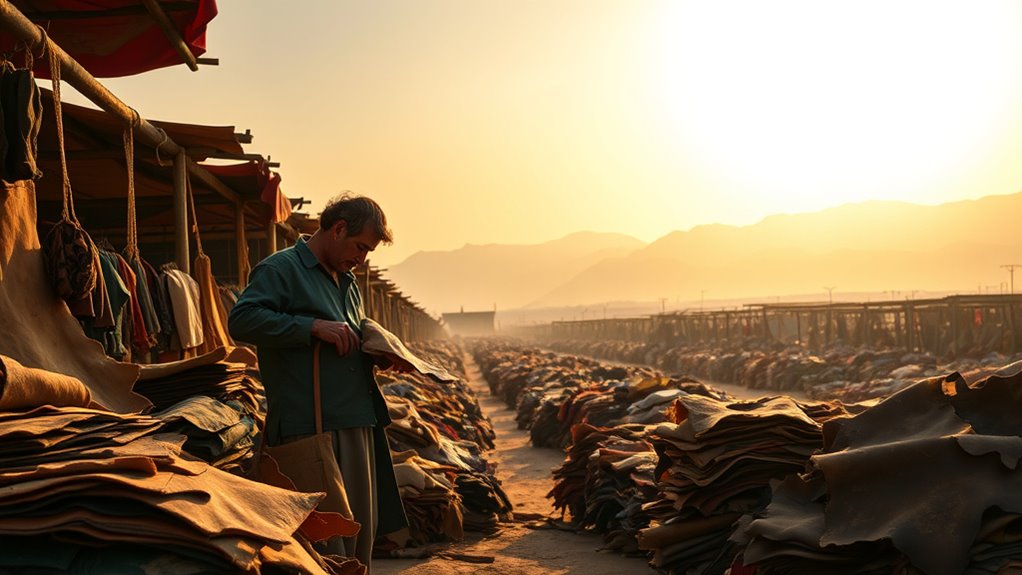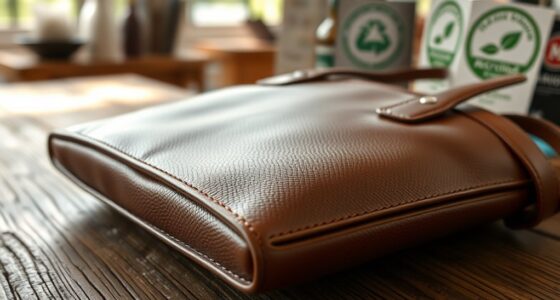Climate change is transforming leather sourcing globally by forcing farmers to adapt livestock practices for resilience and shifting supply chains due to extreme weather damaging processing facilities. Industry players are turning to sustainable materials like plant-based leathers and recycled fibers to lower environmental impact. Innovations streamline logistics and increase transparency, even as emerging markets face infrastructure challenges. Understanding these shifts reveals how the industry is evolving to meet new climate realities—keep exploring to see the full picture.
Key Takeaways
- Extreme weather events disrupt supply chains, damage processing facilities, and delay raw material availability in leather sourcing.
- Climate resilience drives adoption of sustainable livestock genetics and grazing practices to maintain herd stability.
- Growing demand for eco-friendly and cruelty-free alternatives leads to increased use of plant-based and recycled materials.
- Supply chain innovations, including blockchain and infrastructure upgrades, enhance traceability and resilience against climate impacts.
- Regulatory shifts and industry initiatives promote sustainable sourcing, reduce environmental harm, and encourage eco-conscious practices worldwide.
Shifts in Livestock Farming and Cattle Supply Chains
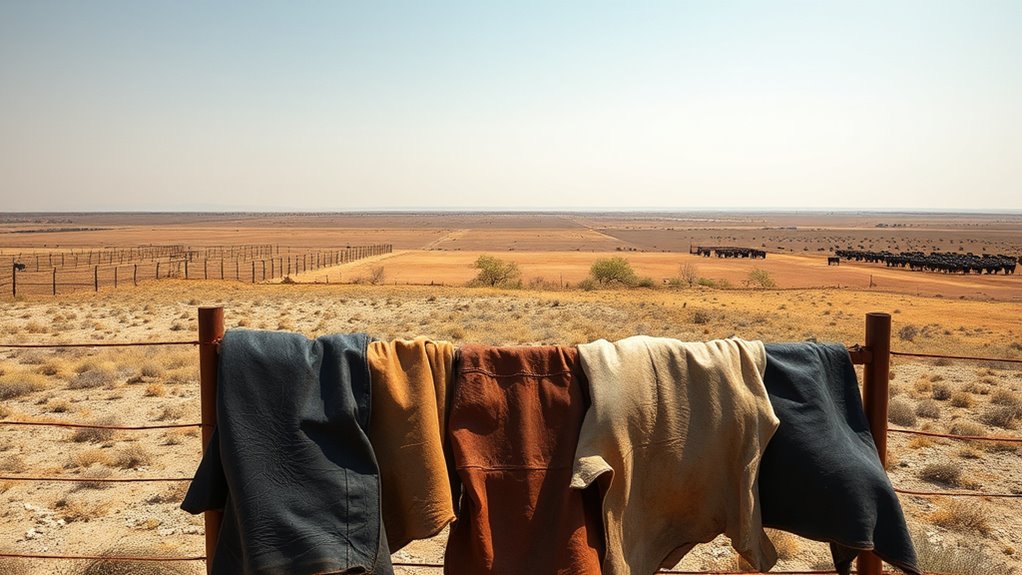
As climate change accelerates, livestock farming and cattle supply chains are experiencing significant shifts. You’ll notice farmers adapting their practices, especially in livestock genetics, to breed animals better suited for changing environments. These genetic improvements often focus on resilience to heat and drought, ensuring herd productivity amid unpredictable weather. Grazing practices also evolve, with farmers shifting to rotational grazing or relocating herds to more sustainable pastures. These changes help conserve water, reduce land degradation, and maintain pasture quality. Additionally, integrating natural materials into farm infrastructure can improve the resilience of farming operations under climate stress. Farmers are increasingly adopting climate-resilient livestock to better withstand extreme weather events, which is crucial for maintaining supply stability. This shift towards sustainable livestock management is essential for adapting to the long-term impacts of climate change on agriculture. Moreover, enhancing environmental sustainability in farming practices can lead to healthier ecosystems and improved soil health, further supporting resilient food production systems. These adaptive strategies are also supported by advancements in livestock genetics, which help develop breeds that are more tolerant to changing conditions. As a result, supply chains become more flexible and resilient, but they also face new challenges in sourcing and management. Overall, these adjustments in livestock genetics and grazing practices are vital to maintaining cattle supplies and supporting the leather industry’s sustainability amid climate change.
Impact of Extreme Weather on Tanning and Processing Facilities
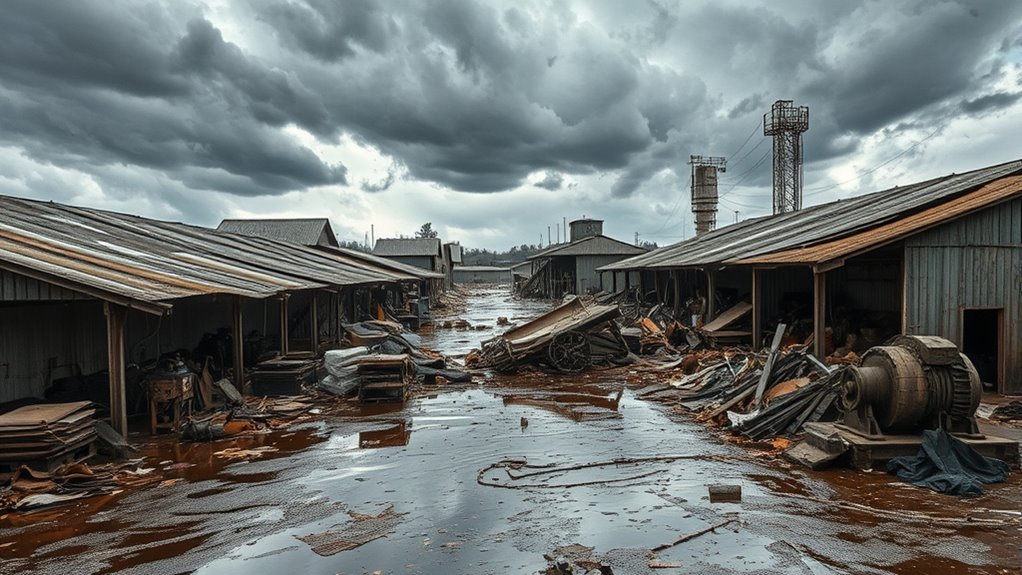
Extreme weather events can cause significant damage to tanning and processing facilities, leading to costly repairs and downtime. These disruptions often result in increased expenses and delays in production. As climate change intensifies, you’ll need to contemplate how storm damage and operational interruptions impact your supply chain. Incorporating sustainable sourcing practices can help mitigate some risks associated with climate-related disruptions. Additionally, understanding the shelf life of grape juice and its spoilage signs can inform inventory management during these unpredictable events.
Supply Chain Disruptions Increase Costs
Have recent extreme weather events substantially impacted tanning and processing facilities? These disruptions strain transport logistics, making it harder to move raw materials and finished products efficiently. As delays mount, market volatility increases, causing prices to fluctuate unpredictably. You might find costs rising due to tighter supply chains and limited availability of key inputs. This unpredictability forces you to adjust sourcing strategies and often pay more for expedited shipping or alternative materials. The ripple effect impacts your overall expenses, squeezing profit margins. While some regions recover quickly, persistent weather patterns continue to challenge the stability of supply chains. Incorporating climate-resilient practices into your sourcing can help mitigate these impacts and maintain a steady supply of leather products. Building diverse supply networks becomes essential to adapt to ongoing climate-related disruptions and ensure consistent procurement. Considering renewable energy solutions for processing facilities can also improve resilience and reduce operational costs amid climate challenges. Additionally, adopting sustainable sourcing practices can help future-proof your supply chain against environmental uncertainties, especially as HEPA filtration and other air quality technologies become more relevant in maintaining safe processing environments.
Facility Damage From Storms
When storms intensify, they can cause significant damage to tanning and processing facilities, disrupting leather production. Severe weather events threaten infrastructure stability, forcing delays and costly repairs. To improve storm resilience, many facilities are investing in upgrades like reinforced roofs, flood barriers, and backup power systems. These enhancements help protect equipment and ensure continuous operation during storms. For example, facilities that prioritize storm resilience can minimize downtime and maintain supply chain stability. The table below illustrates common facility upgrades and their benefits:
| Upgrade Type | Benefit |
|---|---|
| Reinforced roofs | Prevent roof damage during high winds |
| Flood barriers | Reduce flooding risk |
| Backup generators | Maintain power during outages |
| Elevated equipment | Avoid flood-related damage |
| Storm-resistant doors | Enhance overall structural resilience |
Adoption of Sustainable and Alternative Materials
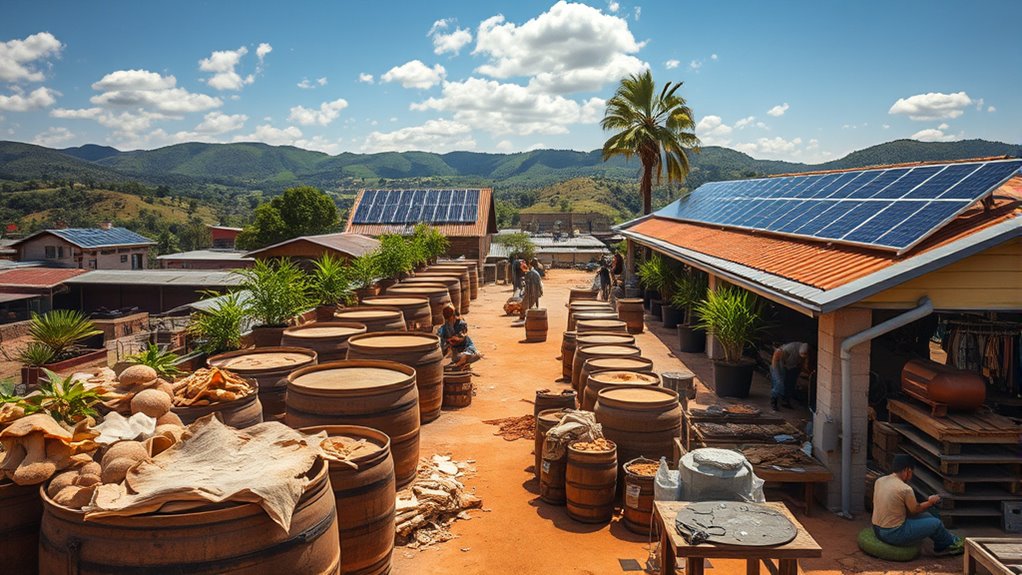
You can explore how plant-based leathers are gaining popularity as eco-friendly alternatives to traditional leather. Innovations in recycled materials also offer sustainable options that reduce environmental impact. Embracing these materials allows you to make more responsible sourcing choices in response to climate concerns. Additionally, understanding ethical considerations in sourcing can help ensure that these sustainable options are produced responsibly and ethically. For example, implementing sustainable manufacturing practices can further enhance the environmental benefits of alternative materials. Furthermore, adopting traceability systems can improve transparency and verify ethical compliance throughout the supply chain. Incorporating efficient general ledger coding into your supply chain management can streamline tracking and reporting processes, supporting responsible sourcing initiatives. Moreover, integrating climate-resilient sourcing strategies can help adapt supply chains to the changing environmental conditions caused by climate change.
Rise of Plant-Based Leathers
As awareness of environmental impacts grows, more brands are turning to plant-based leathers as a sustainable alternative to traditional materials. These vegan alternatives reduce reliance on animal agriculture, which notably lowers greenhouse gas emissions and land use. Plant-based leathers are often made from materials like mushroom mycelium, pineapple leaves, or cactus, offering eco-friendly options that align with ethical sourcing principles. By choosing these innovative materials, you can help promote cruelty-free products and reduce environmental harm. Consumers increasingly seek brands that prioritize sustainability, and plant-based leathers meet this demand by combining style with responsibility. As the market expands, expect more high-quality, durable options that challenge conventional leather, making ethical sourcing more accessible and impactful worldwide. Recognizing patterns in consumer preferences can further accelerate the adoption of these sustainable options, supporting a healthier planet. Incorporating innovative material development into production processes ensures these products are both environmentally sustainable and supportive of family well-being. Additionally, understanding consumer motivations can guide brands in creating more appealing and meaningful products for environmentally conscious buyers. Furthermore, advancements in waterproofing and cleaning techniques can help extend the lifespan of plant-based leather products, promoting long-term use and sustainability.
Innovation in Recycled Materials
How are innovative recycled materials transforming the leather industry? By harnessing textile recycling, manufacturers can repurpose waste into high-quality leather alternatives. This material innovation reduces reliance on traditional animal hides and minimizes environmental impact. Recycled fibers from post-consumer textiles are processed into sustainable materials that mimic leather’s look and feel, offering a viable eco-friendly option. You’ll see brands adopting these recycled materials to meet consumer demand for sustainability and to lower their carbon footprint. This shift not only conserves resources but also promotes circular economy principles within the industry. As technology advances, recycled materials become more durable and versatile, making them increasingly attractive for fashion and footwear. Overall, innovation in recycled materials is reshaping sourcing practices, making sustainable leather alternatives more accessible and impactful.
Innovations in Leather Production and Supply Chain Management
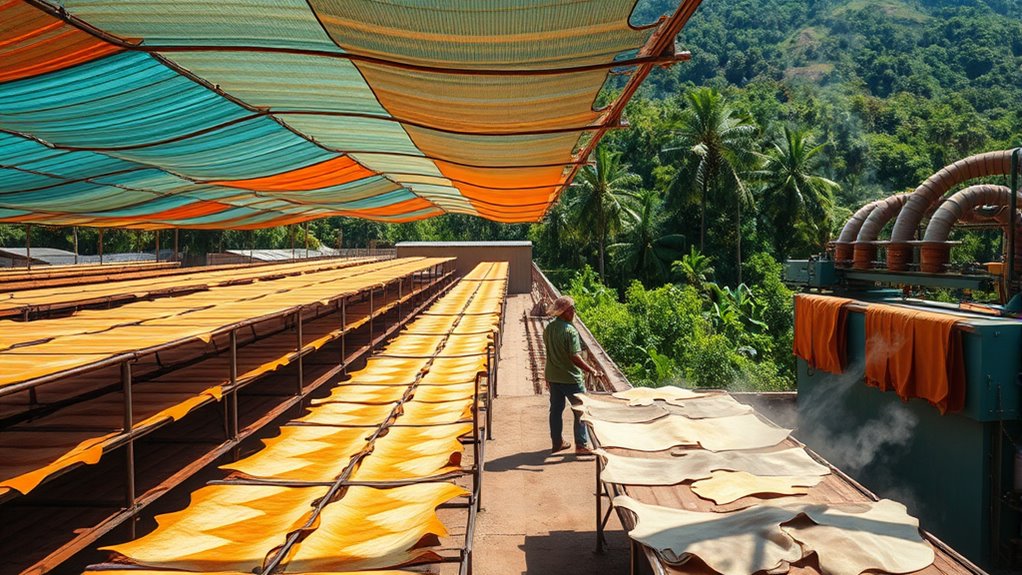
Innovations in leather production and supply chain management are transforming the industry by making it more sustainable and efficient. New techniques focus on reducing environmental impact while supporting wildlife conservation efforts. You’ll find companies adopting ethical sourcing practices, ensuring that animal welfare and local communities are prioritized. Blockchain technology is improving traceability, allowing you to verify the origins of leather products and confirm responsible sourcing. Advanced processing methods minimize water and chemical use, lowering pollution and conserving resources. Additionally, implementing sustainable practices helps companies meet increasing consumer demand for ethically produced, eco-friendly leather. Supply chain innovations also streamline logistics, reducing carbon footprints. These developments help you meet increasing consumer demand for ethically produced, eco-friendly leather. As a result, the industry is shifting toward more transparent, sustainable practices that balance business needs with environmental and wildlife conservation.
Challenges and Opportunities for Emerging Markets

Emerging markets face unique challenges in adopting sustainable leather sourcing practices, including limited infrastructure, lack of regulatory frameworks, and limited access to advanced technologies. These hurdles can slow progress but also open doors for urban innovation, where new solutions can be piloted to improve supply chains and resource management. Market diversification presents another opportunity; by expanding beyond traditional markets, you can reduce dependency on volatile sectors and tap into emerging consumer demands for sustainable products. Embracing these strategies allows you to build resilience against climate impacts and global shifts. While the obstacles are significant, leveraging urban innovation and diversifying markets can position your region as a forward-thinking leader in sustainable leather sourcing, fostering economic growth and environmental responsibility simultaneously. Understanding sustainable practices can help emerging markets navigate these complex challenges effectively.
Policy Changes and Industry Initiatives Toward Climate Resilience
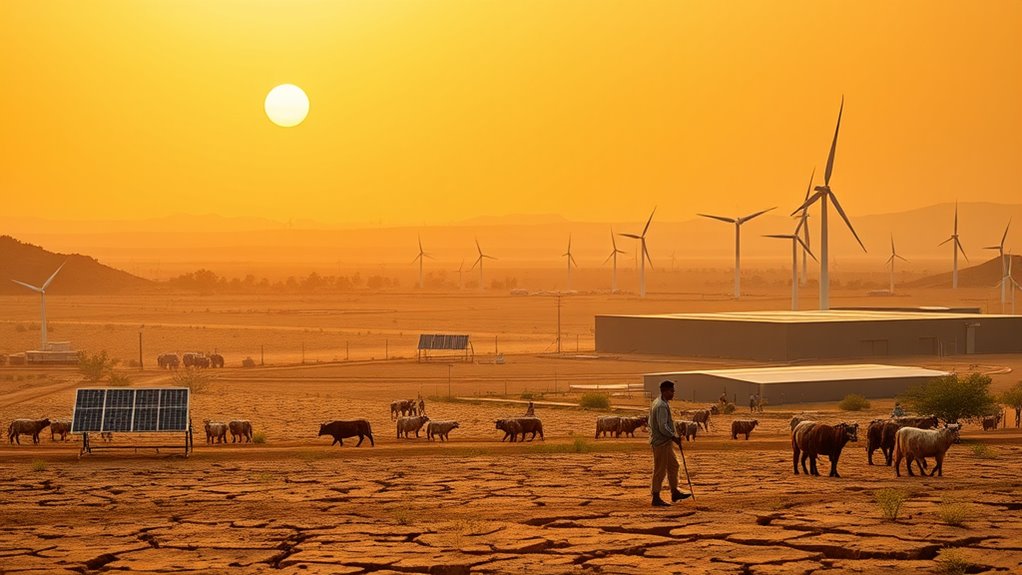
Policy changes and industry initiatives are increasingly shaping the path toward climate resilience in leather sourcing. Governments are implementing stricter climate policies, encouraging sustainable practices. Simultaneously, industry standards are evolving to prioritize eco-friendly methods and materials. These efforts drive companies to adopt transparent supply chains and reduce carbon footprints. Here’s a snapshot of key initiatives:
| Initiative | Description | Impact |
|---|---|---|
| Climate Policy Incentives | Tax breaks for sustainable practices | Accelerates eco-friendly investments |
| Certification Standards | Eco-labels for sustainable sourcing | Builds consumer trust |
| Industry Collaborations | Shared best practices and technologies | Enhances overall resilience |
| Regulatory Frameworks | Stricter emission regulations | Promotes cleaner production methods |
Frequently Asked Questions
How Will Climate Change Affect Leather Pricing Globally?
You’ll see climate-driven price fluctuations impacting leather globally, as changing weather patterns affect livestock health and availability. These conditions lead to raw material cost impacts, making leather more expensive when droughts or floods disrupt supply. As climate change intensifies, you can expect increased volatility in leather pricing, forcing manufacturers and consumers to adapt to higher costs and seek sustainable sourcing options to mitigate future price swings.
Are There New Certifications for Sustainable Leather Sourcing?
Imagine you’re stepping into the future’s marketplace—new sustainable certifications are emerging to guide eco-conscious buyers. You’ll find eco label standards that verify ethical sourcing and environmental responsibility, ensuring leather products meet strict criteria. These certifications, like the Leather Working Group’s standards or Global Organic Textile Standard, help you make informed choices. Stay updated, and you’ll confidently support brands committed to sustainable practices in a changing climate.
What Role Do Consumers Play in Promoting Eco-Friendly Leather?
You play a key role in promoting eco-friendly leather by making eco-conscious choices and supporting brands that prioritize ethical consumption. Your purchasing decisions influence market trends, encouraging companies to adopt sustainable practices. By demanding transparency and certifications, you help shift the industry toward more environmentally responsible sourcing. Your awareness and advocacy create a ripple effect, inspiring others to choose ethically made leather and contribute to a more sustainable future.
How Do Water Shortages Impact Leather Tanning Processes?
Imagine water scarcity hitting leather tanning like a tsunami—your supply chain would drown in chaos. Water shortages severely disrupt tanning processes, forcing manufacturers to seek costly and innovative solutions. Tanning innovations become essential as traditional methods falter under drought conditions. You might face delayed production, increased costs, and a push toward sustainable practices that conserve water, reshaping the leather industry in unpredictable, climate-driven ways.
Will Traditional Leather Industries Survive Rising Climate Regulations?
You might wonder if traditional craftsmanship can withstand rising climate regulations. As governments implement stricter rules, leather industries could face export restrictions, making it harder to access certain markets. However, many producers adapt by adopting sustainable practices or innovating with eco-friendly materials. While some traditional methods may decline, others will evolve, ensuring the survival of leather industries by balancing heritage with environmental responsibility.
Conclusion
As climate change continues to influence leather sourcing, you should consider how shifting cattle populations—up 15% in some regions—affect supply chains. Extreme weather damages processing facilities, prompting you to explore sustainable alternatives. Embracing innovations and policy initiatives can help you navigate these changes while reducing environmental impact. Staying adaptable is essential; after all, the industry’s resilience depends on your ability to innovate amidst a 40% increase in climate-related disruptions over the past decade.
